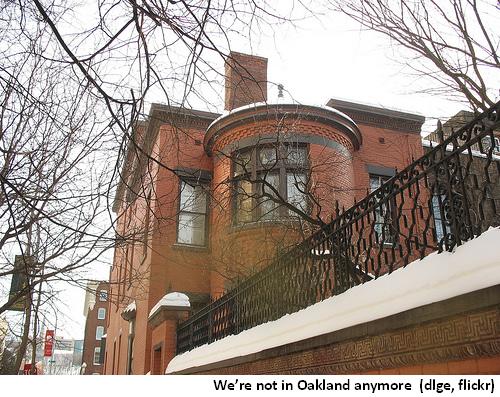Community-based policing in Oakland is, at best, a work-in-progress. Among the 57 beats scattered through the city, there are great differences in whether neighbors get involved in crime prevention councils. We understand that beat officers are not spending 100% of their time locally, either.
In Montclair, we have two active councils that communicate priorities to Beat 13Y and 13Z officers. We let them know where to patrol and share other concerns on a regular basis, and we often complain about slow response times when calling for help. Our crimes are mostly about burglaries and stolen cars, rather than murders.
Like all Oaklanders, we still wonder when community policing will hit its stride. This combination of neighbors and local cops, working together, shows real promise but hasn’t been fully realized yet.

Tucker Talked The Talk
Wayne Tucker, Oakland’s soon-to-be former police chief, has been chanting “the mantra” of geographic and local policing efforts for several years. In this 2007 interview with Phil Tagami (part one, part two), he focused on filling 22 of the 57 problem-solving officer (PSOs) positions and reaching 803 officer positions overall. Tucker also believed the force should add another 300 officers.
Chief Tucker will make his swan-song this Wednesday, at the Neighborhood Watch Steering Committee meeting. Montclair’s Nick Vigilante said the Chief plans to “address the major achievements at OPD under his command, as well as what still needs to be done and what role the residents of Oakland can play in it.”
- You’re invited to this presentation on Wednesday, from 6:30 – 8:30pm. It takes place at City Hall, 1 Frank Ogawa Plaza, in Hearing Room 4 (map), and please RSVP to Felicia Verdin at fverdin-at-oaklandnet.com or 510-238-3128.
With Tucker’s retirement as well as the severe budget gap, we wonder about changing priorities within Oakland Police department. Will some of the community efforts fall by the wayside? Or will it be up to citizens to keep things going?
Community Policing Might Suffer
Just today, City Attorney John Russo jumped into the fray regarding policing priorities: “We must confront the painful truth that too many good Oakland residents live as if under siege. We need more officers, but we don’t need them doing desk jobs that a civilian could do. We need more officers investigating and solving violent crimes. We must have a commitment to to effective crime fighting and continued, serious reform of the Oakland Police Department.”
The Alameda County Court recently issued a tentative ruling in Marleen L. Sacks v. City of Oakland. Judge Frank Roesch ruled that Measure Y funds were used improperly by the City. In particular, he found that funds had been used for general police training and not specifically for community-policing functions. Appeals have been filed by the City Attorney’s office at this point. [Feb. 24th: The City Attorney’s office expects to recommend an appeal filing, if the ruling is affirmed.]
Meanwhile, the budget continues to crash and burn, and the actual gap isn’t known yet. The City Council’s Finance and Management Committee, headed by our City Rep Jean Quan, is looking at additional taxes to solve problems and is gamely trying to repeal the Measure OO which passed last year. At some point, there have to be tougher calls which reduce headcount and salary levels – just like the private sector.
Power To the People, UNCO
Today the crime prevention councils function solely at the beat level, and citizens share safety concerns with their beat officers. Perhaps by unifying and giving a larger voice to councils’ concerns, there could be more coordinated responses from their assigned PSOs or other cops on duty.
With this goal in mind, the first-ever United Neighborhood Councils of Oakland (UNCO) Congress is taking place tomorrow night. The original drafters, including Montclarion Jim Dexter, believe this group will enable more direct communications to Oakland Police brass and other city officials.
- Everyone’s welcome to participate in this first Congress on Tuesday, beginning 7:00 pm. It takes place at Patten University Activity Center, 2433 Coolidge Avenue (map), and no RSVP is required here.
By attending, you have opportunities to run for UNCO leadership roles as an Executive Committee officer or as a Public Safety Area (PSA) representative. The meeting will also break into the six PSAs, so neighbors can begin identifying local issues as well.
Regardless of Oakland’s budgeting travails or police reforms, it’s heartening to see that citizen volunteers are trying to amplify their contributions anyway. This kind of volunteerism should help keep community policing alive – even in the most troubled times.
Feb. 28th Update: It’s the last day for OPD Chief Wayne Tucker, with coverage by the Tribune, Chronicle, and NBC News. Earlier this week, KTVU and Tribune reported about the Neighborhood Watch meeting. Tucker said the city was “woefully inadequate in terms of responding to property crimes. We just don’t have staff to do those kinds of things.”




